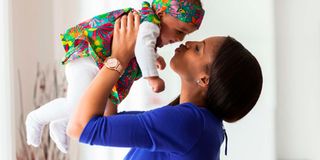How to help a baby with squinted eyes

What you need to know:
- You should not be too worried if your child seems to have a squint within the first two months. However, if the squint goes beyond this, then it is wise that you have the baby checked
Irene Kiragu noticed that her one-year-old daughter would be looking at her but her head would be facing a different side.
“Her head [w]ould be facing sideways, and yet one of her eyes could react to my movements,” she says. “She [w]ould also look at me with her left eye closed.”
Alarmed, Irene began to pay attention to her daughter’s eye movements. She realised the left eye often looked outwards.
“I took her to an eye clinic in our area where she was examined and found to be having a divergent eye squint,” says the mother of one.
According to Evans Oduor, an eye specialist, squints are a result of misalignment caused by difficulty in focus.
“The child’s eyes do not appear to look in the same direction due to refractive problems such as long sightedness,” he says.
In some cases, this misalignment may persist throughout the child’s life.
Oftentimes, one eye remains the dominant focusing eye - the one that sees – while the other squinted eye does not focus. Its impulses and focus are ignored by the brain.
A squint, also known as strabismus, is usually considered normal in newborns. This is because a newborn’s eyes will tend to wander or appear occasionally crossed during the first few months after birth.
Squints begin to manifest after 4 to 6 months. This means the eyes haven’t straightened out and are either wandering in, out, up or down.
Unlike Irene, who was able to have her daughter’s squint diagnosed early, many parents fail to detect the disorder early enough, or they believe that squints are an act of nature, or natural deformity, that they can't do anything about.
“I had noticed that my son had a squint. But it never really bothered me. I didn’t think it could grievously affect his life or self-esteem. He didn’t have many problems with reading or carrying out school and household activities,” says Charity Muraya.
Among older kids or adults, one of the generic solutions for squinting is wearing glasses even though according to Evans, this is not the ultimate remedy.
Moreover, squints present a high possibility of becoming permanent if not well treated.
Causes and Symptoms
Squints are quite common: they affect at least one in every 20 children. In most cases, they develop within the first three years of the child’s life.
Often, though, the child is born with the squint; but sometimes the condition may also develop within the first six months after birth.
“You should not be too worried if your child seems to have a squint within the first two months. However, if the squint goes beyond this, then it is wise that you have the baby checked,” says Evans.
According to him, the most common symptom you should be on the lookout for is the failure of one eye to focus straight.
“Such refractive errors may occur in one or both eyes. This effectively interferes with the early brain development of binocular vision.”
As a result, because the eyes cannot focus correctly together, the brain fails to learn how to use both eyes to focus together on an object.
“For example, if the left eye is dominant the brain will suppress the image from the right eye and weaken its control and focus,” says Evans.
This also means that with squints, one eye will turn inwards, upwards, downwards, or outwards, while the other eye will focus on one spot.
Hereditary squints
Some squints are hereditary. For instance, if you have a family with a history of squints, chances of your child developing one are high.
Children with cerebral palsy, Noonan syndrome, brain tumor and hydrocephalus are also vulnerable to squints.
“Children with neurodevelopmental delay and motor control difficulties are at an increased risk of squints,” says Evans.
Other symptoms may include poor vision, blurred or double vision in the affected eye, which the child may try to deal with by spontaneously covering or closing the affected eye.
A squint may cause the child to have a lazy eye – also known as amblyopia – which if not treated before the child reaches age seven, may cause permanent visual impairment.
“Squints are the most common cause of amblyopia. This effect occurs with the failure by the child to use one eye early on in childhood,” says Evans.
Diagnosis and Treatment
With squints, the younger and faster the child is treated, the more improved their eyesight and eye focus will be.
Noteworthy is that while certain squints are obvious, others may be difficult to detect and only manifest at later, more detrimental stages.
In most cases, possible squints are detected by shining a light on the eyes from a distance.
During such tests, the reflection of the light should constantly appear in the same position in both eyes.
However, there are other tests that may be administered. For example, the doctor might cover the eye in focus and observe the squinted eye as it moves to locate objects without the other one.
Evans further notes that if the squint is detected early enough, proper treatment may help the brain to develop binocular vision.
In some cases, the normal eye may have to be patched in order to compel the brain to use the affected eye. “An operation may also be necessary to tighten the muscles around the eye,” he says.
Takeaway
Types of squints include:
Hypertropia is when the eye turns upwards
Hypotropia is when the eye turns downwards
Esotropia is when the eye turns inwards
Exotropia is when the eye turns outwards
Eye hospitals
Some of the hospitals and eye clinics you can take the baby if you suspect squint are:
Kikuyu Eye Hospital
Kenyatta National Hospital
All District Hospitals at Level Five and above.
Upper Hill Eye and Laser Centre
Lions SightFirst Eye Hospital Countrywide
Who to consult:
If you suspect that your child has a squint problem, you may consult the following specialists for guidance, proper diagnosis and treatment.
Paediatrician
Orthoptist
Ophthalmologist (eye surgeon).



